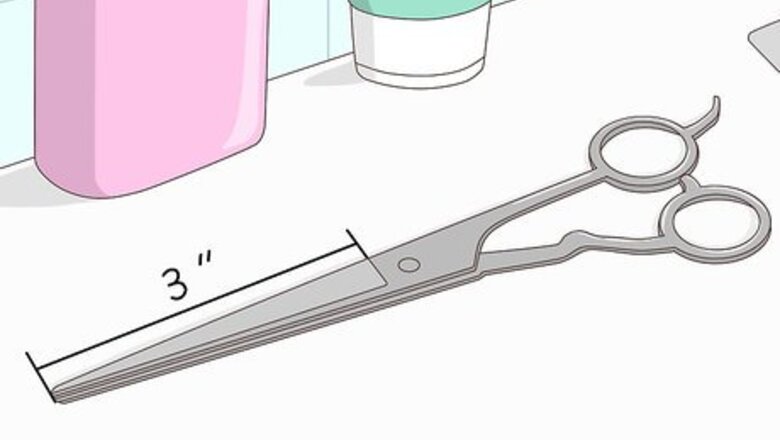
views
Preparing for the Cut

Buy a pair of high-quality hair scissors. You should be able to find these in your local drugstore or beauty supply store. They will range in price from $10 to $15 (USD). Try to stick to smaller shears with blades around 2.5 to 3 inches (6.3 to 7.6 cm) long. The shorter the blades, the easier it will be for you to control what you cut.
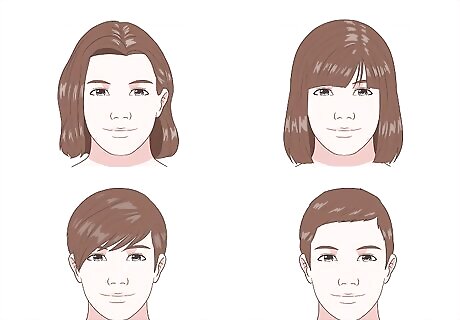
Decide on the style of your haircut. Knowing what sort of haircut you want before you get started will keep you focused and less likely to make mistakes. To decide on a style, browse celebrity pictures online; flip through hairstyle magazines (available in magazine racks at most drugstores and bookshops); play with your hair in the mirror to see what it looks like at different lengths; print out photos of yourself and sketch different hairstyles on to your face. There are some phone apps and websites that will let you try on different hairstyles over a photograph of yourself. It's important not to be rash with your decision. If you decide that you want to go from very long to very short hair, give yourself at least a few days to think about it before you decide to do it. You may find that you're just feeling unhappy, and once that passes, you might miss your long hair. If you're planning on making a significant change to your hairstyle, you might want to consult a professional to make sure that it goes exactly right. You can always trim your hair at home.
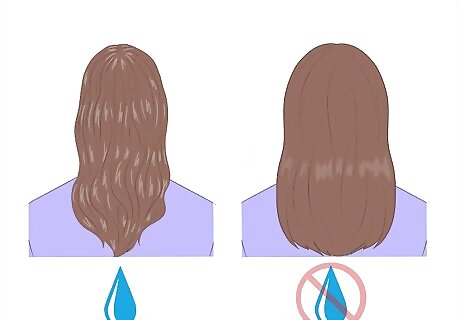
Decide whether you want to dry or wet cut your hair. Many professionals recommend cutting your hair wet, as it is easier to manage and control. Some professionals also recommend cutting hair dry, as it allows you to see the effects of the cut right away and adjust for any quirks such as cowlicks or curls. If you cut your hair while it's wet, cut it at least a few inches longer than you want it, as it will shrink up and look shorter once it is dry. (Some people have reported that their hair shrinks up to 4 inches from wet to dry.) Dry cuts are more likely to produce uneven hair. Cutting hair dry requires very sharp sheers. Cutting dry hair will dull the blade edge very quickly, which pushes ends instead of cutting them, leading to uneven lines. Most professionals cut the hair while it is wet and refine it once the hair is dry. Doing this will let you produce better looking results while giving you a chance to fix minor errors.

Prepare your hair for cutting. If you're cutting your hair wet, shampoo and condition it, remove excess water by wrapping your hair in a towel and squeezing it, then comb your damp hair straight. If you want to dry cut your hair, wash and dry it, part it where you would normally part it, then get it as close as possible to how you would normally wear it. If you normally straighten your hair, straighten it before cutting. Avoid putting any products into your dry hair before cutting it, as these could make it more difficult to properly evaluate your cut. EXPERT TIP Courtney Foster Courtney Foster Licensed Cosmetologist Courtney Foster is a Licensed Cosmetologist, Certified Hair Loss Practitioner, and Cosmetology Educator based out of New York City. Courtney runs Courtney Foster Beauty, LLC and her work has been featured on The Wendy Williams Show, Good Morning America, The Today Show, The Late Show with David Letterman, and in East/West Magazine. She received her Cosmetology License from the State of New York after training at the Empire Beauty School - Manhattan. Courtney Foster Courtney Foster Licensed Cosmetologist A common mistake when cutting your hair is using dull instruments. Make sure the hair scissors you choose are adequately sharpened because dull scissors cause split ends. Another issue people have is not cutting their hair evenly. Your hair needs to lay correctly on your head if you want layers.
Cutting a Low Ponytail
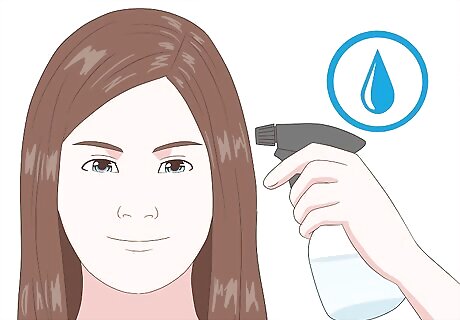
Start with clean, damp hair. If you've recently washed your hair, there's no need to wash it again. You can wet it by spritzing it with some fresh water. This look will give you a straight hairstyle that may appear to be slightly rounded from the back.
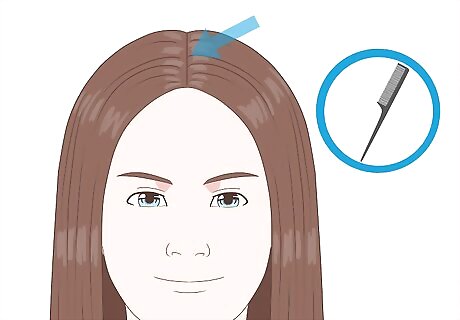
Part your hair in the middle. Part your hair in the middle back to the top of your crown. Behind this point, comb back your hair straight. Be as exact as possible as you part your hair. Use a fine-toothed comb to comb your hair on either side of the part.

Pull your hair back into a low ponytail at the nape of your neck. Using the fine-toothed comb, ensure that your hair is smooth and firm against your head as you pull it back into a tight ponytail. Comb your hair all over to ensure that there are no bumps before you pull it into the ponytail. Ensure that the ponytail is directly in the middle of the back of your head, and that it sits very low at the nape of your neck.

Place another ponytail holder in your hair. This ponytail should be just above where you want to cut your hair. It may be a few inches below the other one.

Pull the ponytail gently up towards the ceiling. Do this without loosening it from the nape of your neck.
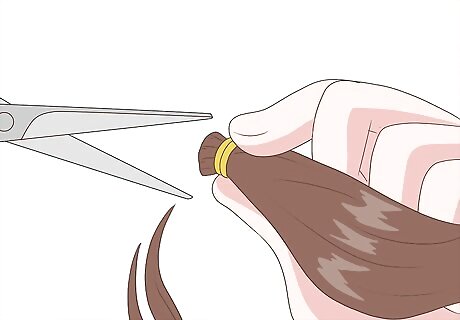
Clip off the excess hair from below your second ponytail holder. Do this in small, incremental snips. Don't try to cut the entire chunk of hair in one go. Make sure that the end of the ponytail is as even as possible.
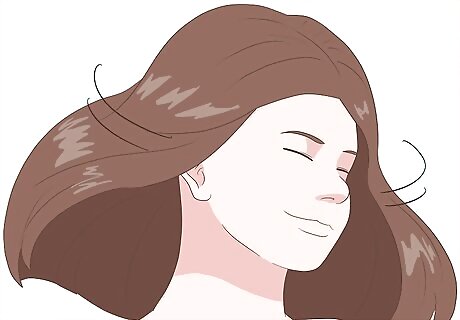
Remove the ponytail holders and shake out your hair.

Evaluate and polish. Comb sections straight up or forward to check for evenness. Adjust the cut as you would like. If the cut is not as even as you'd like it to be, you can try putting it in a ponytail and trimming it again. Do not cut it any shorter; just put it back in the ponytail, hold it firmly in one hand, and clip any stray hairs that aren't even with the others.
Using the Twist Method
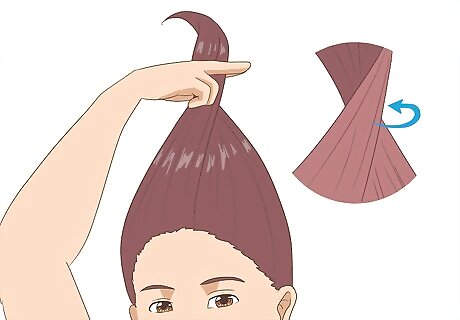
Comb all of your hair to the very top of your head and twist it tightly. This cut will give you a more angled haircut, and it is ideal if you want an inverted bob. Keep in mind that this method will not remove much length from your hair, but cutting a lot of hair can result in heavy layering as well as significant weight removal from your hair, which may not make it ideal for fine or thin hair.

Cut off however much hair you want. Holding your hair firmly up above your head, cut into it with scissors. You can determine where the shortest layer will fall by pinching a piece of hair from the front hairline where you want the shortest layer to fall. Pull it back to where you will twist. This can act as a guide for where to cut.

Let go. Let your hair fall back down and run a comb through it.
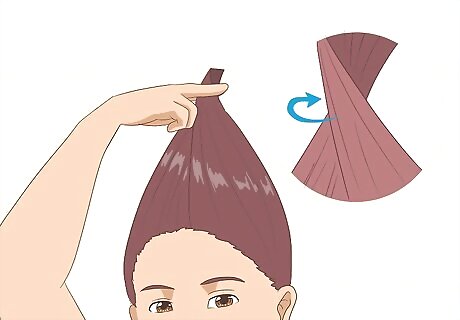
Twist your hair in the opposite direction. Pulling your hair up once more, twist it in the opposite direction.
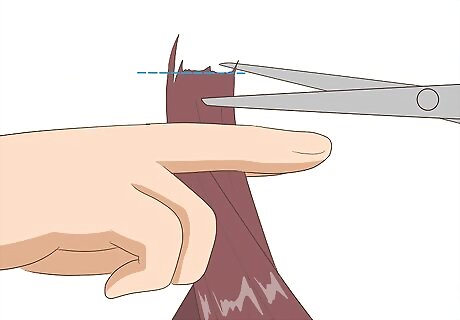
Cut off any straggly hairs. Holding your twisted hair up over your head again, move across the ends of it, snipping away any hairs that stick out.

Let go and comb out. Let go of your hair and comb it out, styling it as you wish.
Using the Twist Method for a Pixie Cut
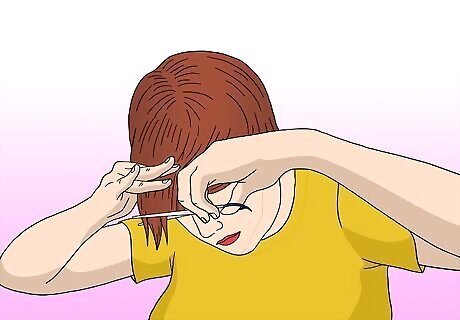
Section off fringe at front of hair. If you want a longer fringe or bangs, comb out a section from the top of your hair before starting on the larger haircut. If you don't want bangs, move to the next step. How you cut your bangs will depend on the style of your pixie cut. For wispy bangs that blend with your pixie cut, cut into your fringe at a 75-degree angle while moving diagonally across your face. For more blunt bangs, cut straight across from ear to ear, moving across your hair in small sections as you go.

Comb all of your hair to the very top of you head and twist it tightly.

Cut your hair. Put your fingers near the bottom of how long you want your crop to be, and cut there.

Comb down your new short hair.
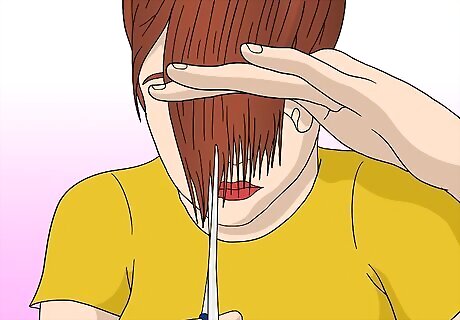
Take a thin vertical row of hair, and cut vertically up, or down it. You want to cut a straight, even line as you do so. Take as much off as you want to achieve the desired length.
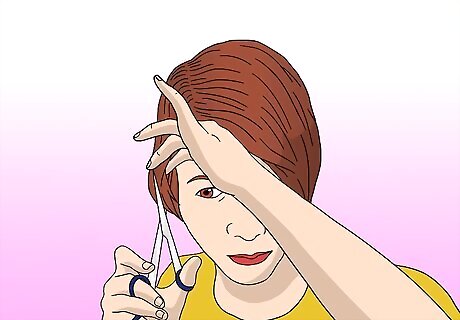
Continue to cut the rest of your hair. Using the previously cut section as a guide, pull a small amount of hair into parallel to the first cut section, and cut accordingly. Continue taking parallel sections, using a small piece of the last cut section as a guide. Refine the edges when you are done so that it is even and balanced.
Cutting a High Ponytail
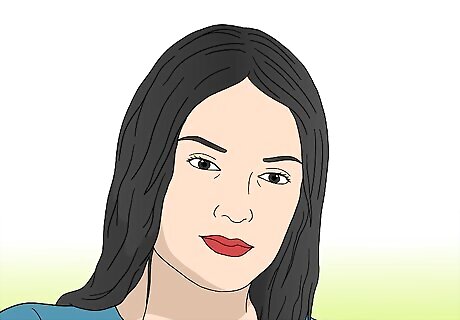
Start with clean, damp hair. This cut will give you heavier layers on the top of your hair. If you've recently washed your hair, you needn't wash it again. You can simply wet it using a spray bottle and some fresh water.
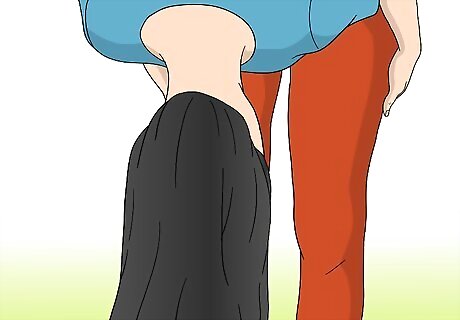
Bend over at the waist, with your head pointing downward. If you don't want to turn upside down to cut your hair, you can also do the high ponytail method while standing upright. Just hold the high ponytail up over your head in one hand as you follow the rest of these steps.
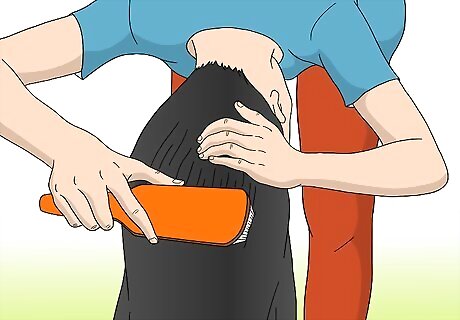
Comb or brush your hair into a ponytail near the top of your head. Do this while you are still bending over at the waist, with your head pointing downward. To ensure that your hair is as even as possible, aim for a ponytail that is right at the centre and top of your head. Use a mirror to help you determine the position of the ponytail.
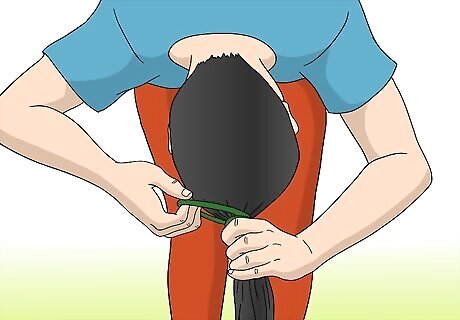
Secure your ponytail tightly with an elastic band. Put this first band close to your scalp so that your hair cannot slip out of it.

Place another elastic band further down the ponytail. This second elastic band will sit just below where you want to make the cut.
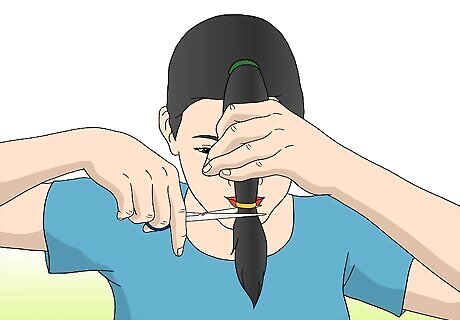
Cut your hair just above the second elastic band. Holding the bottom of your hair firmly in one hand, hold scissors in the other hand and use them to cut through your hair. Do not try to cut through the entire ponytail of hair all at once. Make small snips until you are all the way through the ponytail.
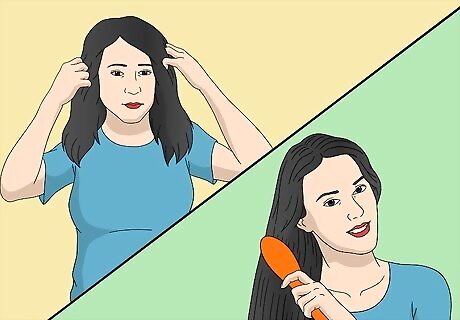
Release your hair from the ponytail. Remove the elastic band and shake out your hair. Brush it and run your fingers through it.

Make some finishing touches. If it looks too blunt or uneven, flip your hair over once more, again securing it into a ponytail at the top centre of your head, then, holding the ponytail in one hand, trim any stray hairs that hang out of the end of the ponytail. There shouldn't be many stray hairs. If you see a lot of them, move the ponytail around on your head until the hair is mostly even when you grasp it in your hand. For a more natural look, you can make some small, upward cuts into the ponytail. This will soften the ends of your hair so that the cut looks less blunt. It will also give it more of a shaggy look, incorporating any unevenness into the style.
Cutting a Front Ponytail

Ensure that your hair is clean, smooth and dry. This is particularly important to do before you start cutting, especially if you have frizzy hair. This is a dry cut so there is no need to wash your hair, unless it is dirty/oily. This cut is good if you want more layers framing your face.

Tip your head upside down.

Brush your hair into a ponytail at the centre of your forehead. With your head still upside down, brush your hair forward and gather it into a nice tight, secure ponytail that starts right on your hairline in the centre of your forehead. Think unicorn horn.

Work out how long you want your first layer of hair to be. Are you going for a fringe that ends at your eyebrows or layers that start at your chin? Measure the distance of where your ponytail starts on your forehead to where you want your first layer of hair to fall. You can measure this distance with a comb.
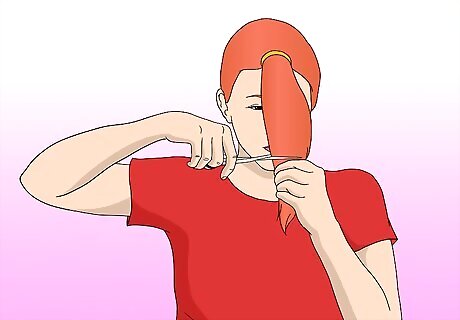
Hold your ponytail firmly with one hand and cut it with the other. Get your scissors and then shear your ponytail off at the length you measured with the comb.

Snip into the blunt end of the ponytail. Change your grip on the scissors now and, pointing them directly into the hair, snip into the blunt end of the ponytail until it looks like a shaving brush: all graduated and fluffy, with no hard lines. Take care to lean forward as you do this so you don't jab the scissors towards your eyes or get bits of chopped hair falling into your eyes.

Pull off the hair elastic and shake your head so your hair falls into place.
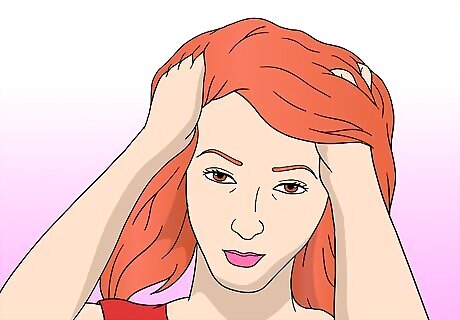
Style as desired.
Cutting Pigtails
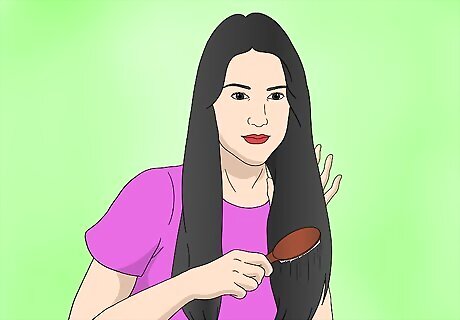
Start with clean, dry, brushed hair. If it's not already straight, you may want to straighten it as well. This haircut may not be suitable for people with fine or thin hair as it will remove quite a bit of weight from the bottom of your hair.

Part your hair in the middle. Using a fine-toothed comb, divide your hair into two equal parts, using a mirror to ensure that the line down the center of your head is straight, and that the two halves are even.
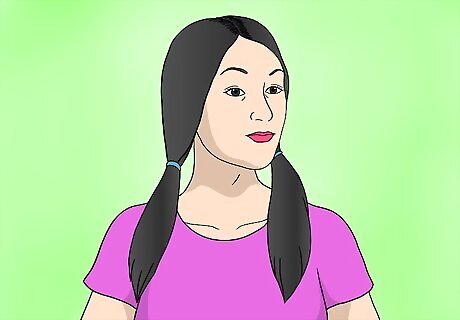
Put your hair in low pigtails. Tie the two halves of your hair into two separate ponytails (also known as pigtails). Ensure that they sit low on your head, behind and below your ears — close to where your hair meets your neck at the sides of your head.
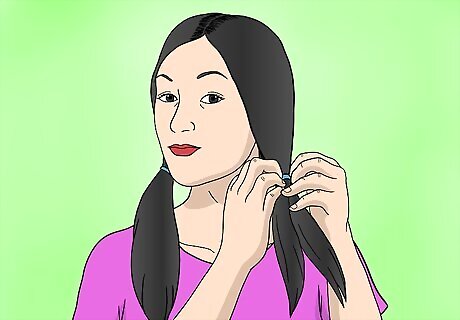
Tighten the pigtails. To tighten each pigtail, grab your hair a couple of inches below the ponytail holder/elastic band, and split it in half so that each hand holds one half. Then, gently pull the two halves away from one another so that the elastic band moves upwards, closer to the base of your head.
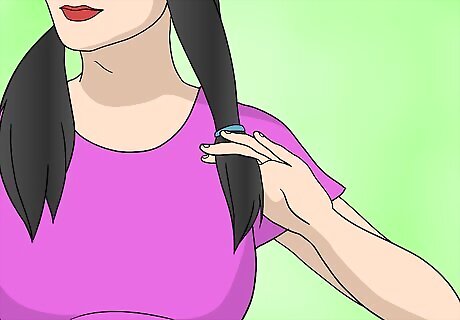
Pull the elastic bands around your pigtails down evenly and slowly. When you've reached the desired length STOP!

Cut your hair just beneath the elastic band. Do this for both sides. If you cut your hair straight across, it will look choppy; for a more natural look, hold the scissors at a 45-degree angle and cut upward into your hair.
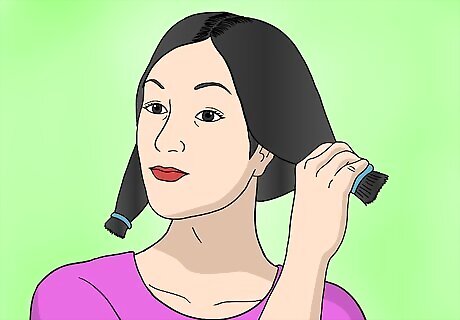
Remove the ponytail holders. Once you've cut each pigtail, you'll notice that your hair comes to a point at the back. If you like the V-shape at the back of your hair, move on to the next step. If you don't like it, you can remove the point by tying your hair into a single ponytail at the nape of your neck, and then clipping off the point.
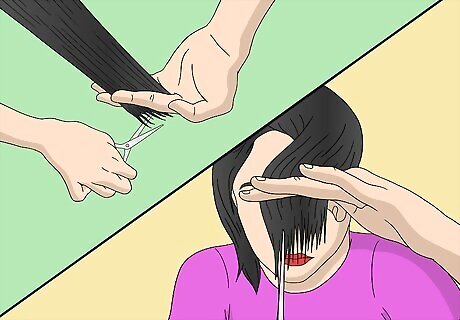
Polish your cut. Trim your ends and snip any bits of hair that seem longer than the rest. When point-cutting into the ends, hold the scissors at a 45 degree angle to the hair.
Cutting While Upside Down

Wash and towel dry your hair. There is no need to blowdry your hair as you'll want it to still be slightly damp for this cut.

Place a towel on the floor in front of you. This will catch the pieces of hair as you cut them.
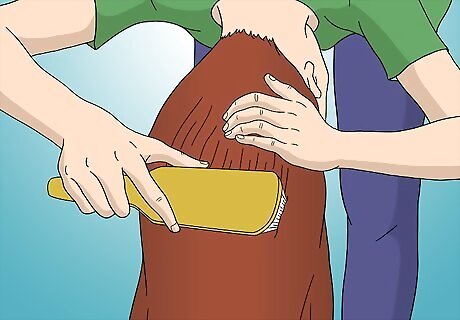
Flip your head over and brush all of your hair in the direction of the floor.
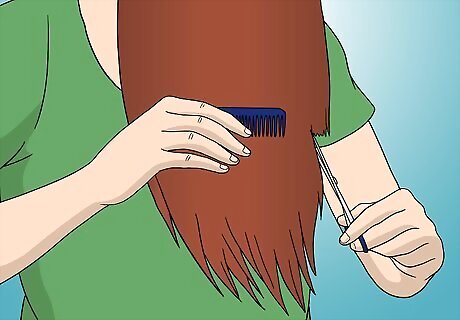
Cut in small sections, moving left to right. Cut parallel to the floor, being careful not to move your head. After each small section, run a comb through your hair to ensure that you're cutting it as evenly as possible. Always take off less than you'd like, as your hair will be slightly shorter when it's dry. Remember, you can always take off more hair; go slow and be conservative in your cuts.

Stand upright and evaluate. Once you're done, you should have evenly trimmed hair with some long layers in it.
Cutting Back to Front
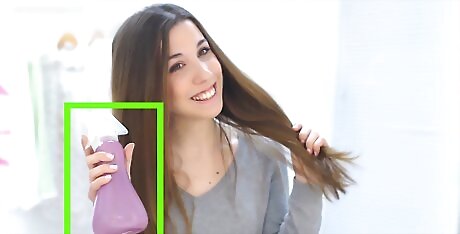
Ensure that hair is clean and damp. If you have recently washed your hair and do not wish to do so again, you can spray your hair down with a spray bottle full of fresh water, instead.
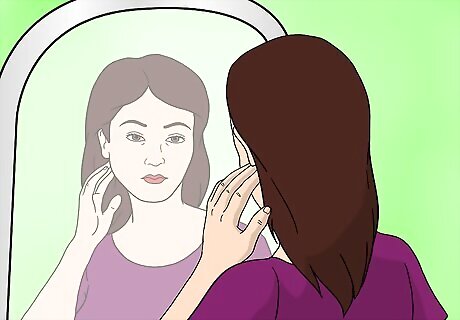
Stand in front of a mirror. If possible, stand in front of a large bathroom mirror, with another mirror placed behind you so that you can see what you are doing from both sides.
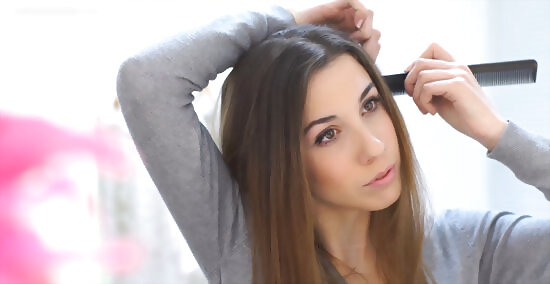
Comb hair along desired part lines. Do this while holding your head in a neutral position — not tilted to one side or the other, or too far back or forward.

Split hair into eight sections. Divide your hair into the following sections: bangs, top-front (left and right), top-back (left and right), sides (left and right), and one section at the nape of your neck. Twirl each section around your finger before clipping it up and out of the way. Leave the section at the nape of your neck out; this is the one you will start with, as cutting your hair from back to front is easier than front to back. If you have thick hair, you may need to further divide these sections, particularly at the top-front and top-back of your head, and the nape of your neck.
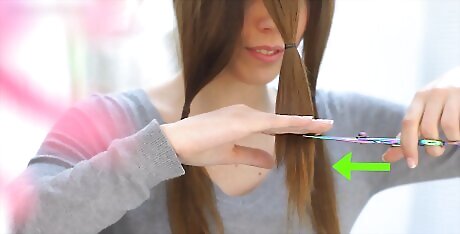
Hold the scissors appropriately. You'll need to hold the scissors differently depending on what type of haircut you want. If you want a blunt (straight across) cut, you'll need to hold your scissors horizontally as you cut straight across your hair. If you want a softer, more natural and layered look, you'll need to turn your scissors at a 45-degree angle and cut upward into your hair, making small diagonal cuts. For a more wispy edge (like for bangs), first cut your hair to the desired length, then, making an almost vertical angle with your scissors, cut upward in one quick motion into your hair. Only do a few of these per section of hair, otherwise it will look too wispy and sparse.
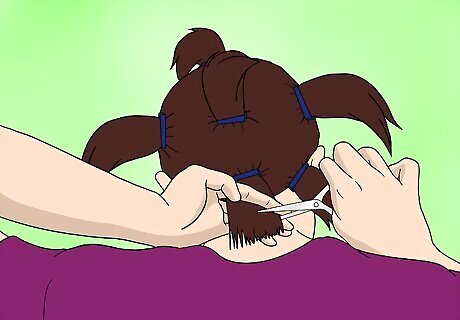
Begin cutting the section of hair at the nape of your neck. Bring the hair in front of your shoulders. Comb the section out. Take firm hold of it between your pointer and middle fingers (as if those two fingers are a pair of scissors cutting your strand of hair), and comb through the section again. Pulling the hair taut, slide your fingers down the section until they are just above where you want to cut, then use your scissors to cut just beneath your fingers.
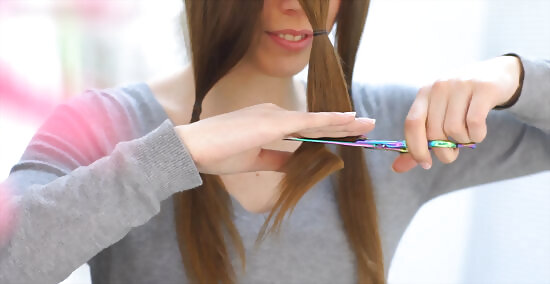
Continue cutting the rest of your hair. Once you are happy with the section at the nape of your neck, let down the top-back right section of your hair and cut that. Then let down the top-back left section of your hair and cut it so that it's even with the top-back right and nape sections. Work from back to front, section to section, until all of your hair is even. Don't forget to comb out each section before you cut it. If your sections begin to dry out before you get to them, give them a quick spritz of water before combing them out and cutting.

Add layers. Once you've finished cutting all of your hair evenly to one length, you can add layers. For a more natural look, you might choose to cut small sections of hair at random. When creating layers on longer hair, it is important to create varying mid-length layers for a professional, graduated look.

Wash and dry hair. Shampoo, condition, and rinse your hair. Then dry it with a towel or a blow-dryer — whichever you prefer.
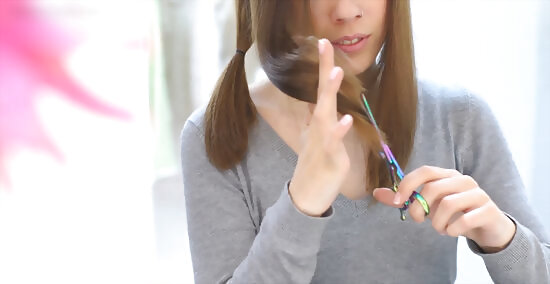
Clean up any uneven bits. Once your hair is clean and dry, have another look at it to make sure everything is even and that any layers you've introduced are well-blended. You might find more uneven bits as time goes on. Don't get upset — just fix them as you find them.










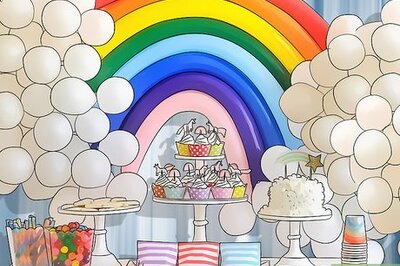

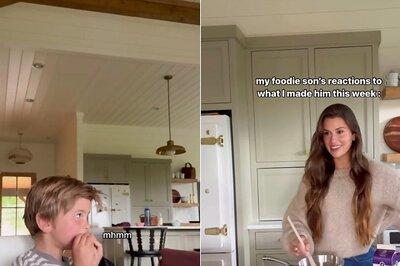


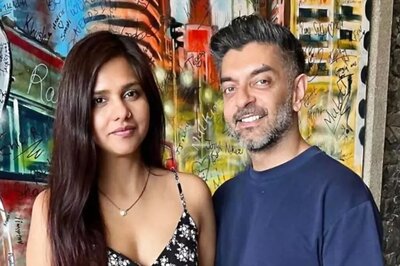


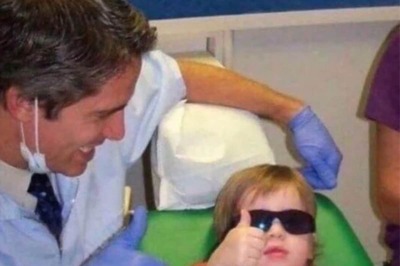
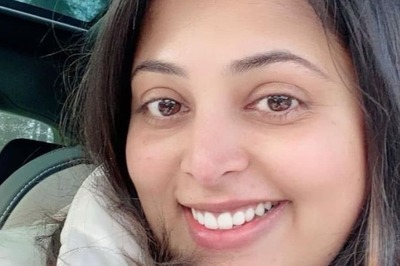
Comments
0 comment